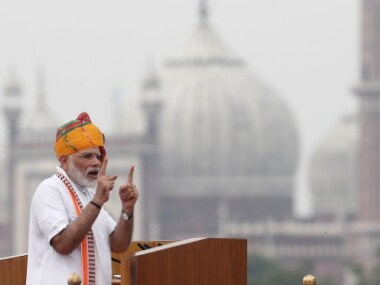Is there a population explosion as Prime Minister Narendra Modi asserted in his Independence Day speech ? India’s population grew by 17.64 percent between 2001 and 2011 to 1,210.9 million. This is faster than China’s 5.43 percent population growth during the same period. But, the last decade was also the first time after 1911-21 when India added fewer numbers than the previous decade. India’s population is increasing but at a slower pace. The United Nations population division, in its report released in June, said India would overtake China to become the most populous country in 2027. In 2015, it had said this would happen in 2022. In 2017, it had placed the event in 2024. “How can there be a population explosion when 24 state and union territories have total fertility rates (TFR) at or below the replacement level of 2.1?” asks Poonam Muttreja, executive director of the Delhi-based Population Foundation of India (PFI). The organisation was set up in 1970 by enlightened philanthropists like JRD Tata and Bharat Ram to advance “human welfare through family planning”. Replacement-level fertility is the rate at which the population replaces itself from one generation to the next. [caption id=“attachment_7189321” align=“alignleft” width=“380”]  Prime Minister Narendra Modi addressed the nation on Independence Day from Red Fort in Delhi. Reuters[/caption] The prime minister’s comments had the potential of being misused by those wanting to create communal fissures. The Muslim community has a higher, but falling fertility rate. Its members have also been called upon time and again to affirm their patriotic credentials by shouting certain slogans. Sure enough, Shiv Sena’s mouthpiece Saamana, in its editorial for 16 August, asked “fundamentalists” in the Muslim community to change their mindset of “hum do hamaare pachhis” (we two, ours 25). This prejudice is not supported by facts. Fertility rates are declining across religious communities and socio-economic groups. According to the latest National Family Health Survey, the fertility rate of Hindus is 2.13. That of Muslim women is 2.62. In 2005-06, this was 2.59 and 3.4 respectively. There has been a steeper decline in fertility among Muslim women. In four states with sizeable Muslim presence — Jammu and Kashmir (68 percent), West Bengal (27 percent), Kerala (26 percent) and undivided Andhra (10 percent) — the fertility rate is either 1.6 or 1.7, which is below the replacement level. Even in populous Uttar Pradesh, where the share of Muslims is 19 percent, the gap between Hindu and Muslim fertility rates is shrinking. Uttar Pradesh’s TFR is 2.74. Hindu women have a TFR of 2.67, a decline of 1.06 children per woman from a decade ago, while that of Muslims is 3.10, a reduction of 1.23 children. In Bihar, which is 17 percent Muslim, the TFR is 3.41. The fertility of Hindu women at 3.29 is below the state average, while that of Muslim women is 4.11. A decade earlier, it was 3.86 and 4.81 respectively. In 2001, a Muslim woman on average had one child more than a Hindu woman. By 2011, the difference was 0.6 children. The gap in fertility rates between the two communities is narrowing. Population control got a bad connotation after forced sterilisation drives during the Emergency. A ‘cafeteria approach’ was later adopted, giving people a voice in the choice of contraception. This has worked. India’s numbers are growing because of population momentum caused mainly by a large young population in the reproductive ages, says Muttreja. But it cannot be business as usual. Measures need to be taken to stabilise the population. The median age of marriage for women in India is 19. But there are large numbers of women who marry before the legal age of 18. Enrollment of girls in schools, checking their dropout rate, keeping them longer in schools, and providing job opportunities will help deal with the issue. The fertility rate for women with no schooling is 3.1 while for those with 12 or more years of schooling it is 1.7. Sadly, the share of women in the workforce is low and falling. It has decreased from 26 percent in 2005 to 22 percent in 2018. More than coercion, this calls for good governance. There is a need to increase the budget for family planning, which is four percent of the meagre outlay for National Health Mission, says PFI. In surveys, women have indicated that their “wanted” fertility rate is 1.8, suggesting a desire for smaller families. About 30 million women have their contraceptive needs unmet, which results in unwanted pregnancies. Recognising this, in 2017 the health ministry launched mission Parivar Vikas to increase access to contraceptives and family planning services in 146 high fertility districts. The basket of contraceptives was expanded to include injectible Centchroman and Progesterone Only Pills (POP). The compensation for sterilisation was enhanced in 11 high-focus states. This is the way to go. There is a need to create social and behavioural change in favour of smaller families, says Muttreja. But the approach should be need-driven, rights-based and voluntary. Coercion would be a violation of people’s rights. Strangely, BJP MP Rakesh Sinha introduced a population regulation bill in the Rajya Sabha in July. It proposes penalties for those with have more than two children after enactment of the legislation including disqualification from election contests, reduction in subsidies on loans, lower rate on bank deposits, the lesser entitlement of subsidised food grains and higher than normal interest rates on loans. Hopefully, the government will not back it.
India’s population grew by 17.64 percent between 2001 and 2011 to 1,210.9 million. This is faster than China’s 5.43 percent population growth during the same period. But, the last decade was also the first time after 1911-21 when India added fewer numbers than the previous decade.
Advertisement
End of Article


)

)
)
)
)
)
)
)
)



